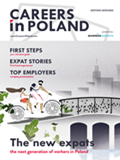From job posts to social media: How can employers attract young talent?

Editor

Jordan Encarnacao on Unsplash
related articles
related offers
What do students want from work?
With Gen Z entering the job market, many talented young people aren’t just looking for a classic nine-to-five, rinse-and-repeat office routine. They’re searching for opportunities where they can grow, learn, and feel genuinely appreciated. But how can employers meet these expectations in practical measures?
Our parent company MBE Group has analyzed the responses on 954 students in a 2024 report A po studiach idziemy do pracy. (eng. And after studies, we go to work). And based on this research, the prospective professionals in Poland value:
- Career development & training: A whopping 64% of respondents are drawn to employers offering clear development paths and training programs.
- Attractive benefits: When salaries aren’t sky-high at the start, 36% of students appreciate a solid benefits package that helps bridge the gap.
- Real-world projects: About 30% are interested in examples of actual projects and business cases—they want to see the proof in the pudding.
- Behind-the-scenes glimpses: Nearly a quarter of students (27% and 26%, respectively) love learning about employee career journeys and the fun, inclusive side of company culture.
Read on: How do students in Poland search for their first job?
In what industries would students want to work the most?
Almost 90% of students consider the industry in which a potential employer operates as a major factor in their decision-making. Here’s a quick breakdown of the top sectors:
- Education & Science: 24%
- Media & Advertising: 22%
- Medical industry: 22%
- Finance: 19%
- IT: 19%
- Fashion & Beauty: 18%
If your company belongs to one of these sectors, or if you’re considering diversifying your messaging to appeal to a broader range of interests, tailor your communication to highlight industry-specific growth opportunities and innovations.
How to get to the student audience?
First things first, though. If you want to reach the student audience, you’ll probably get the most success by meeting them where they spend the most time – online. But which social media platforms get the most student engagement?
The study reveals that:
- Instagram, Facebook, and YouTube are the reigning champions – over 80% of students use these platforms daily. Think of them as the Holy Trinity of social media for employer branding.
- TikTok, with 77% of students using it daily, is not to be overlooked, however. This platform is a playground for creative, fun, and engaging content.
- LinkedIn, though the go-to for many professionals, sees only 9% daily engagement among students. It turns out that strict professionalism isn’t always on a student’s agenda – except when they’re doing deep dives into job markets or scouting potential employers.
Based on these insights, the best is to focus your primary employer branding efforts on Instagram, Facebook, YouTube, and TikTok. LinkedIn, on the other hand, could be used strategically for more detailed, career-focused content rather than daily engagement.
Read on: Is your company's hiring strategy working for or against you? Here’s how to find out!
What makes a great employer message? Crafting the perfect tone of voice
The tone of your communication can make or break your connection with student job seekers. Here’s what the study found regarding communication style preferences:
- 65% of students appreciate a friendly and open tone that maintains a respectful boundary between employer and employee.
- 22% prefer an ultra-casual, barrier-breaking style – think “Let’s grab a coffee and chat about your career” rather than the almost lawyer like “Please be advised that…”
- Only 13% are into stiff, formal, and more distant communications.
As always, clarity is key. Students appreciate straightforward messages that detail job responsibilities, expectations, and even salary ranges.
Therefore, it might be best to avoid clichés, like “dynamic team” or “fruity Mondays”. Yes, they might look good in a job advert, but at times they can come off as too generic or simply insincere.
In practice, this essentially means one thing: "Abandon all corporate jargon, ye who enter here".
Try embracing authenticity. A sprinkle of humor here and there (think: witty captions or playful emojis) can help humanize your brand without compromising professionalism.
Authenticity and accessibility: The amazing “A”'s of communication
In a world where information is just a click away, both students and employers must adapt to new communication models.
Students crave clarity and realness. Here are the key elements that catch their eye:
- Clear, direct communication: Students want to know exactly what the job entails. They appreciate clear job descriptions, including transparent pay ranges and responsibilities.
- Visual appeal: Engaging graphics, videos, and other multimedia elements can elevate your message. An eye-catching design is as important as the content itself.
- Showcasing company culture: Authentic behind-the-scenes looks at your team, workplace activities (from team-building retreats to casual office moments), and employee testimonials can significantly boost your employer brand.
- Inclusive messaging: Make sure your communication reflects an inclusive environment where every individual can feel welcome. After all, a diverse team is often a creative and innovative one.
- A touch of humor: A well-placed joke or playful remark can help cut through the noise on social media. Just be sure to keep it light and genuine.
Therefore, for employers, the goal is to create messages that are clear, engaging, and tailored to the digital spaces where young job seekers live their virtual lives.
One last piece of advice
By embracing a clear, friendly, and visually appealing communication strategy – one that leverages popular social media channels and speaks directly to what students value –employers can build a compelling employer brand.
If there is one sentence lesson to be learned from all this data, it would be: keep it real, keep it accessible, and finally – don’t be afraid to loosen your metaphorical collar a bit.
.












